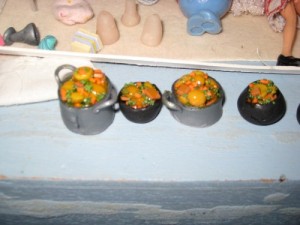So I really did mean to post progress before now, but it just didn’t happen. Although last weekend I did get a fair bit done. Finishing the faux-stone work, especially the “mortar” was a fair bit of work (hard on the hands to squeeze the bottle since I made the mix thicker, but not all that time consuming.)
I stained the floor. I made and stained a false door. This one is coffee-stirrer sticks on cardboard so it will curve slightly on the back wall. I also cut and hot-glued shingles made of squares of sandpaper to the roof piece, and spray painted black when finished.
To the right in the picture is the opening front of the shop and one of two shelve units. Yeah, let’s not discuss the angle of the shelf units, since they’re far from perfect, and I hope by the time I get them done, they’ll look decent. All made of cardboard and card, and they’re only coated in gesso so far.
The opening section of the shop I’m much happier with. I started by cutting down a piece of salvaged plastic packaging to the correct height, and hot gluing it in place. Then, to cover the ugly seaming on the inside of the wall, and the joints between the window and the mortar wall, I used that favorite method of thin paper layered with water and glue (this was a tad thicker than usual tissue paper.)
The final detail I completed at this stage was painting on the window leafing with metallic charcoal 3-D fabric paint. It’s getting closer to completion. 🙂 This week will be onto painting and assembly.
Thanks for stopping by and reading, and remember: what happens in the craft room, stays in the craft room. 🙂 Have a great week.







